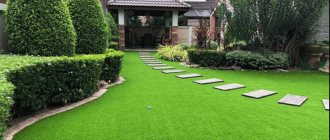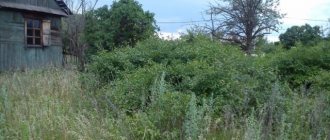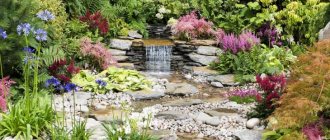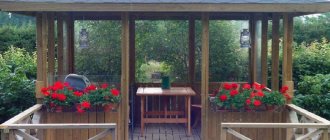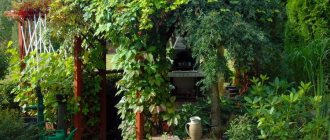In an effort to create a landscape design at their dacha with their own hands, many gardeners make the grave mistake of planting only shrubs, trees and flower beds, while completely forgetting about the “flooring” of the garden - the lawn.
But what if, after hearing a lot about the difficulties of growing lawn grass, you are worried that you simply do not have enough energy to prepare the site, fight difficult-to-eradicate weeds, painstakingly grow seeds, fertilize, regularly water and mow? There is a way out - sow the area not with grass, but with a flowering lawn mixture and create a colorful, easy-to-maintain Moorish lawn at your dacha.
Such a decorative variegated or single-colored lawn is formed by including thirty or even forty meadow flowers and grasses in the traditional mixture for lawn grass.
DIY Moorish lawn
What is Moorish lawn
The village lawn owes its appearance to the Moors (hence the name), who once, many centuries ago, owned part of Spain. Travelers who first set foot in the city of Cordoba, the center of Moorish art, culture and science, were amazed by the richness of the ennobled oasis. Everything in this cozy city was incredibly beautiful. But the garden laid out around the palace was especially beautiful. Well-groomed and large, with fountains and ponds, it was all planted with wildflowers, emerald lawn grass and ornamental grasses.
The new solution to the usual lawn was to the liking of European nomads. They adopted the custom of planting wild flowering grasses and grains in desert areas, partially replacing their neatly trimmed lawns with naturally beautiful, low-maintenance flowering meadows - Moorish-style lawns.
The advantage of lawns of this type lies mainly in the fact that they can be located even in those areas of the garden where the soil is depleted and dried out (or waterlogged). You don’t have to spend a lot of money on them, and it’s very easy to select seeds for a perennial flowering lawn. In order for an ornamental meadow to be covered in flowering throughout the entire season, it is enough to know the flowering time of each plant in the composition.
Story
In the 7-8 centuries AD, when the Arabs and Moors founded their states in North Africa (see Maghreb) and Spain, their rulers - caliphs and emirs (governors of various taifa principalities) began to build grandiose palaces. Hundreds of gardeners, brought from different parts of the world, worked to create wonderful gardens and parks in which European, Mediterranean and Oriental elements intertwined. During the times of developed feudalism, a significant part of certain layers of the population of nominally Islamic principalities were Orientalized Sakaliba Slavs, who, as a rule, came to Spain from Crimea through Constantinople in various ways as mercenaries and slaves. In the 12th-13th centuries they were already quite widely represented in the military class, as well as among the workforce and servants. It is thanks to the influence [ source not specified 1900 days
] to their taste, the Moorish lawn began to more and more resemble a brightly blooming field meadow of Russian forest-steppes.
As a result, in the palace parks of the Sultans of Spain, between the neat trees, instead of the characteristic [ source not specified 1900 days
] green grass for Northern Europe, the earth was full of colors of modest, but extremely attractive wildflowers. Most of the plants that make up the Moorish lawn are excellent honey plants and attract a significant number of bees, bumblebees, and butterflies. This makes the lawn even more beautiful and gives it a special charm.
Cereals, flowers and herbs for the Moorish lawn
So, you have made the final decision to lay out a Moorish lawn at your dacha. Plant seeds for a multi-colored meadow should be chosen that are unpretentious and easy to care for. The area is sown with special mixtures of perennial cereal grasses with the inclusion of perennial and decorative flowering flowers. (The higher the sowing rate, the closer together the flowers will grow).
Important! All flowers should bloom for a long time. And then, after flowering, drop the seeds so that they can germinate again next year.
The best plants for a Moorish lawn
Ornamental perennial grasses
- The bentgrass is thin;
- Timothy grass;
- Fragrant bison;
- Red fescue;
- Meadow bluegrass;
- Zhitnyak;
- Lagurus;
- Perennial ryegrass.
Early flowering bulbous
- Scilla;
- Snowmen;
- Tulips;
- Bow-anzur;
- Grouse;
- Daffodils;
- Crocuses;
- Cyclamens.
Meadow (wild) perennial flowers
- Californian and oriental poppy;
- Nemesia;
- Meadow chamomile;
- Echinacea;
- Quaking grass;
- Arnica;
- Gaillardia spinosa;
- Gentian;
- Loosestrife;
- Tansy.
Annual plants
- Forget-me-nots;
- Nemesia;
- Mattiola bicornuum;
- Delphinium;
- Chernushka;
- Cornflowers;
- Dimorphotheca emarginata;
- catchment;
- Marigold;
- Bells;
- Gypsophila;
- Phlox drummond;
- Linen;
- Lobularia marine;
- Daisies;
- Clover;
- Phacelia bell-shaped;
- Primrose;
- Carnations;
- Nasturtiums;
- Goldenrod;
- Agrostemma sativa;
- Snapdragon;
- Lenyanka and others.
When decorating a low Moorish lawn, anise, thyme, mint and lemon balm are often used. High - fragrant herbs and flowers that release a lot of pollen and thereby attract colorful butterflies and honey bees to the garden.
The bulbous plants in the Moorish lawn will be the first to color the garden in the spring, while other meadow plants barely emerge from the soil. In the summer, when the primroses turn yellow, their fading leaves will be hidden by the lush colors of grass and meadow flowers.
Advice. If you are a beginner, then it is better to start sowing a Moorish lawn with a one-component mixture - without proper, although not difficult, care, a multi-component lawn of several plants will after a while resemble not a charming lawn, but a front garden with weeds. (A lawn made from low-grade carnations and thyme turns out to be incredibly fabulous – it’s a pleasure to grow it yourself).
In the photo below, the following flowers are sown for the Moorish lawn: blue cornflower, chrysanthemum sativa, poppy, common agrostemma and field navel.
Moorish lawn - composition
Material prepared for the website www.moydomik.net
Such a wonderful variegated lawn was made from only 5 species of field plants (on average, a Moorish meadow can include 20-40 unpretentious cereals and flowers). It all depends on the landscape design of your garden.
We create the landscape design of the flower bed ourselves
Types and shapes of flower beds - choose from a variety
Flowerbed is the most used type of flower garden. As a rule, their difference lies in clearly defined geometric shapes (rectangular, oval, round). So, having decided to develop a design, you first need to study its various shapes and types. The most unpretentious option is a monoflower.
- Photos of stones in landscape design
- Photo of roses in landscape design
- Landscaping in front of the house
We recommend that you read
Its design will not take you much time, since flowers of the same colors are planted on it. In addition, the plant variety must also be one - strictly low-growing or strictly tall. Chameleon - the idea is to create a cascade design. To do this, the types and colors of plants are planted in the flowerbed so that they create a smooth transition, blending with the general background.
Many people prefer to decorate their garden plot with arabesques. These are flower beds of a rather complex, bizarre shape. They can be designed in the form of a flower, insect or any animal. A vertical flowerbed resembles a screen - flowers are planted in vases and attached to the frame. The raised flower bed consists of several levels; its height reaches 1 meter or more.
When creating a landscape design with flowers, many choose a mixborder. In other words, this is a flower garden with a free configuration. Here you can show your imagination by combining colors and plant varieties. The main rule is that the flowerbed should consist of flowers that create continuous flowering: some plants fade, while others bloom.
https://youtube.com/watch?v=5kmz9uvNYfQ
From improvised means - inexpensive pleasure
Quite often, when creating a landscape design, the choice stops at the so-called flower borders. They are called plants planted in a row or a small flower garden that frame the path leading to the house. As a rule, low-growing flowers of various colors are used.
Rectangular plantings are called ridges. Planted plants of the same height will look very beautiful on it. Or vice versa, you can plant flowers in several tiers. The landscape design of a self-made flowerbed can be supplemented with a small pond inside it - original and impressive!
It is worth noting that you can easily create a designer planting using scrap materials, without spending a single ruble. You can use bricks, large stones of various shapes, car tires, all kinds of boards cut from wood, old unnecessary furniture, and so on. The most common idea is with tires, which are painted in bright colors and used as flower beds. Simple and beautiful!
Moorish lawn - buy or sow it yourself?
It is easy to buy a mixture for a Moorish lawn for little money in a store for gardeners and summer residents (it is recommended to give preference to domestic seeds) or make the mixture yourself. If we talk about the approximate ratio of plants, it should be as follows: 80% cereal herbs and 20% flowers. Sow the mixture at the rate of 10 g per 1 square meter. m.
If you really want a strongly flowering lawn, then do exactly the opposite of what you would do with store-bought mixtures. Make up your lawn with 70% annuals and 20% short grass. It will turn out very beautiful.
Sowing of the Moorish lawn is carried out in the same way as decorative lawn grass - in early spring. In order for the plants to fully develop and bloom, it is recommended to plant them in unshaded places. If you are planning to organize a meadow among trees, then give preference to plants such as ifheion, kandyk, lily, white flower, arizema, anemone, arum, trillium, snowdrop, etc.
When creating a magnificent living carpet, do not allocate too large, well-lit area for it.
Composition of herbal mixture
In fact, the Moorish type of lawn is an imitation of a natural meadow. Therefore, the herbal mixture includes both flowering plants and cereals.
The most popular of them are discussed below:
- Cornflower is one of the most popular plants. Its small bright blue inflorescences effectively complement the forbs. Of its advantages, it is particularly worth noting its ability to naturally regenerate. Cornflower blooms very quickly and easily, forming spectacular curtains of rich blue color.
- Medium bell . An unpretentious cold-resistant plant with spectacular bell-shaped inflorescences. The flowering period lasts all summer until the first frost.
- Large-flowered flax is an unpretentious and quite spectacular annual plant. There are many varieties and types of flax with flowers of different colors.
- Eschscholzia is a perennial plant grown as an annual. Forms beautiful flowering bushes. Characterized by cup-shaped flowers of a wide variety of colors.
- Meadow chamomile is a perennial plant, the most common inhabitant of natural meadows and glades. Pairs very well with most flowering plants and grains.
- Oriental poppy is a perennial plant with large single flowers of rich scarlet color. It blooms very profusely for 2-3 weeks.
- Gypsophila is a perennial unpretentious plant from the Clove family. Goes very well with annual and perennial flowering plants.
- Ryegrass is one of the most common and fastest-growing lawn grasses. Has very high vitality. Suitable for all types of soil.
- Bluegrass is one of the best lawn grasses. The period of active growth lasts from the moment the snow melts and until the onset of a stable cold snap.
- Fescue is a very strong perennial grass that adapts well to almost any growing conditions.
Planting a Moorish lawn - step-by-step instructions
- Step 1
We free the soil from weeds (we treat heavily infected areas with glyphosate several times) and, after about a month, remove the top layer of soil to a depth of 8-10 cm.
- Step 2
We carefully dig the soil with a shovel to a depth of 25 cm and add low-fat organic fertilizers, sand and peat. This should be done 8-10 days before sowing.
- Step 3
We provide a slope of 3 degrees to drain rainwater from the lawn. (By installing high-quality drainage, you will prevent your flowering lawn from turning into a swamp due to prolonged summer downpours).
- Step 4
Immediately before planting, we level and compact the soil with a bayonet shovel and rake, and then with a garden roller. It is recommended to do this in dry weather.
- Step 5
After leveling, we once again go over the surface of the area with a special lawn rake. This is necessary in order to remove the newly formed bumps after compaction.
- Step 6
On a flat, soft and moderately moist surface, manually sow a mixture for a Moorish lawn mixed with sand in a ratio of 1:3 (approximately 0.0001 g of seeds per 100 g of dry sand). You can sow the area evenly or make islands of flowers by first sowing cereal grasses, and meadow flowers between them.
- Step 7
We immerse the seeds with a rake to a depth of 5 mm, roll them up and carry out drip irrigation (strong water pressure can wash out the crops).
- Step 8
We cover the area with non-woven material - in this case the shoots will be uniform and friendly. But even if the seedlings seem too rare to you, under no circumstances rush to finish sowing - forbs sprout at different times, sometimes the interval can reach 4 weeks.
Moorish lawn care
Lawn mowing
Unlike a parterre or ordinary lawn, the Moorish lawn is cut for the first time at the end of June (when spring flowers are seeded) and the second time in October. But, of course, this is an approximate diagram. A fast-growing lawn may also need mowing in August.
Mowing is another matter. In the first year, it is done in order to prevent fast-growing cereal grasses from drowning out annual wildflowers and to prevent perennials from gaining full strength.
Advice. The first mowing is done in the spring, when the flowers have not yet appeared and the grass has already sprouted.
When there are a lot of early-flowering bulbs in the mixture, mowing the turf is done with a scythe or trimming scissors with extreme caution. The mown grass is carefully raked and removed from the area.
Mowing the Moorish lawn
Removing weeds from the lawn
Weeds will have to be destroyed manually. It will be much more convenient to do this if you plant your lawn with meadow flowers in a narrow strip on the border of the garden or near the fence.
Regular watering of the lawn
High-quality watering is very important in the first two weeks after sowing the lawn. In order not to ruin the newly hatched seedlings, watering should be done by shallow sprinkling, carefully, in several passes. After all the seeds have sprouted, you need to monitor the soil moisture. If necessary, artificial irrigation is carried out.
Lawn Fertilizer
We have already said that the Moorish lawn is the most unpretentious of all. But if you see that the plants in your meadow are growing poorly and turning yellow, this is a reason to carry out unscheduled (minimal!) fertilizing. The most convenient way to feed is complex fertilizers for a flowering lawn, which contain several easily digestible micronutrients. But in no case should you feed your lawn during the first year of life after sowing - complex fertilizers can ruin it. This can only be done next year.
Loosening and aeration of a flowering lawn
An important stage in caring for a Moorish lawn is aeration (ventilation). It is carried out to organize gas exchange between external (atmospheric) air and subsoil air. The essence of the aeration process is to shallowly pierce the soil with a pitchfork or fan rake. Aeration will eliminate “bald” spots and prevent the death of plants that, for example, wither due to rotten roots.
Loosening and aeration of the Moorish lawn
There is one important note: do you want your lawn to be neat and beautifully blooming next year? In late autumn, pull out all the flowers and replant the Moorish lawn next year!
PREPARATION
The soil must be prepared in the same way as for a regular lawn: it must be cleared of weeds, very carefully dug up and fed (preferably with complex fertilizers if this happens in the spring).
An important condition: the dug area should be rolled and the soil leveled so that there is no stagnation of water in uneven areas and the seeds fall evenly on the ground. Sowing should begin in the first half of May, the weather should be calm, it is necessary to sow in moist soil, since many flowers have very small seeds that can fly outside the cultivated area
Next, carefully embed the scattered seeds into the soil using a fan rake. It’s great if you have a lawn roller: you can use it; if not, you can simply water the lawn thoroughly with a light sprinkler.
Link on topic: Do-it-yourself lawn at the dacha: care, sowing, etc.
Moorish lawn – photo
Moorish lawn at a summer cottage
Blooming Moorish lawn on the site
Bright Moorish lawn
Country Moorish lawn
Moorish lawn in the garden
Peculiarities
This lawn option is optimal for those homeowners who do not have much desire or time to regularly use a lawn mower on their property. Creating a Moorish canvas allows you to get a small lawn that will delight you with its bright blooms throughout the warm season.
To create a lawn, special grain mixtures are used. Most of them are cereals - they are responsible for the formation of a dense base. The share of flowering crops accounts for about a third of the total volume of seed material.
Any flower shop sells ready-made mixtures for flowering herbs; they can be sold under the names “blooming” or “alpine” lawn. If desired, anyone can create a grass mixture for such an unusual lawn with their own hands.


